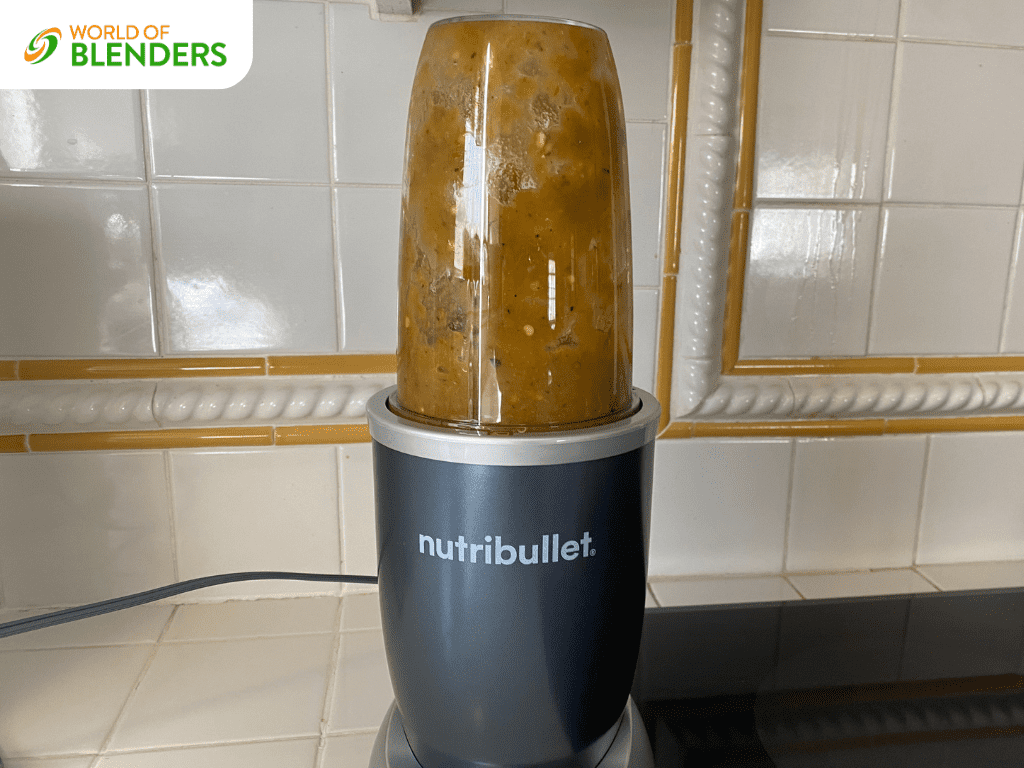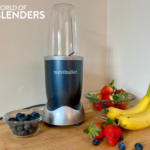This post may contain affiliate links. If you use these links to buy something we may earn a small commission. Thanks.
If you have a NutriBullet, you might be wondering whether you can simply use your blender as a food processor rather than paying for yet another kitchen appliance.
I’ll show you 3 ways you can use a NutriBullet as a food processor. I’ll also walk through some of the pros & cons of prepping food with your NutriBullet.
Be sure to also check out our list of NutriBullet smoothie recipes!
- Can You Use NutriBullet as a Food Processor?
- 3 Ways To Use A Nutribullet As A Food Processor
- Pros & Cons Of Using A Nutribullet As A Food Processor
- The Difference Between A Blender And A Food Processor
- Common Questions About Using a Nutribullet As A Food Processor
- Our Verdict: How To Use A NutriBullet As A Food Processor

Can You Use NutriBullet as a Food Processor?
You can use a NutriBullet as a food processor, though it is somewhat limited. A NutriBullet can be used like a food processor to blend and grind ingredients. However, it doesn’t have all the power and features of a dedicated food processing machine and will struggle with harder ingredients.
3 Ways To Use a NutriBullet as a Food Processor
Three great ways to put your NutriBullet to work as a food processor include chopping vegetables, grinding nuts, seeds, and grains, and mixing sauces, salsas, and dips.
1. Chopping Vegetables
Using the pulsing feature of the NutriBullet makes it easy to chop vegetables like tomatoes, onions, peppers and celery quickly and evenly.

How to use a NutriBullet to chop vegetables
- Place the desired quantity of vegetables in the container.
- Add a small amount of oil or water.
- Repeatedly press the container down – without locking it into place – in order to achieve a pulse effect.
- Continue pulsing until the vegetables reach your desired consistency
Your vegetables will then be ready to use in salads, in salsas, or as part of a larger dish.

2. Grinding Nuts Seeds & Grains
The NutriBullet is great for grinding nuts seeds & grains into powdery mixtures to use as toppings on yogurt parfaits, oatmeal bowls, ice cream sundaes, and more.

How to use a NutriBullet to grind nuts, seeds, and grains
- Place whatever type of nut seed or grain you want in the container.
- Add a little oil if you want some added moisture.
- Pulse until it reaches your desired texture.
Pulsing your blender means pressing the NutriBullet down repeatedly without locking it into place. This will cause the NutriBullet to grind in short bursts.
By carefully pulsing your nuts, seeds and grains, you should be able to reach the consistency of your choice, whether that means coarsely ground chunks or very fine powders.

If you try to blend it steadily or for too long then don’t be surprised if your NutriBullet turns off or stops working.
3. Mixing Sauces, Dips & Dressings
You can use your NutriBullet as a food processor to blend together all sorts of ingredients into delicious sauces, dips, and dressings.

How to use a NutriBullet to mix sauces, dips & dressings
- Put some solid ingredients into the container – for example, garlic, onion, herbs, and spices.
- Add more liquid ingredients, such as oil, vinegar, mayonnaise, or mustard.
- Blend or pulse until the ingredients are thoroughly mixed.
You can try making homemade pesto, hummus, guacamole, ranch dressing, salsa verde, or tzatziki sauce in a Nutribullet. The list of sauces and dressings you can make using this method is almost endless.

Pros & Cons of Using a NutriBullet as a Food Processor
The NutriBullet has several advantages over traditional food processors including:
- Easy to store – Its small size makes it easier to store in tight spaces.
- Quiet – A quieter motor than many food processors.
- Easy to clean – There are only a few blades where food can get trapped, which makes it easy to clean. You can just pour dish soap and water and blend it up to easily clean the blades and cup.
- Easy to use – Just add your ingredients into the cup and press down!
However, as a device that is primarily designed as a blender, there are some downsides to using a NutriBullet as a food processor too.
- Small capacity – It has a small capacity, so it cannot process as large a volume of ingredients as most food processors.
- Blades are not removable – The blades are not adjustable or removable like those found on other types of blenders or food processors, so you may have difficulty getting certain foods finely chopped or blended evenly. This can also make it harder to sharpen blender blades.
- Weaker – It lacks the power of larger food processors and higher-end blenders. If you run it too hard your NutriBullet will smell like its burning.
Whether the pros outweigh the cons will depend on what kind of food processing you want to do. If you simply want to chop a few vegetables or grind a few nuts, your NutriBullet will be up to the task.
But if you’re looking to regularly process large quantities of tough foods to precisely the texture you want, you may need a food processor to get the results you’re looking for.
The Difference Between a Blender and a Food Processor
Blenders and food processors are both kitchen appliances that can help to speed up food preparation by chopping, grinding, shredding, dicing and blending ingredients quickly and easily.
Blenders like the NutriBullet feature a tall cylindrical cup that sits on top of a base. The blades are located at the bottom of the cup and are primarily designed to blend ingredients to make smoothies and milkshakes.
A food processor is an appliance that features a wide bowl containing various interchangeable blades and discs. Unlike a Nutribullet, which has fixed blades at the bottom, a food processor will often feature blades at various heights, including near the top of its container.
The blades of a food processor are designed to chop, slice, shred or grind food in various ways, as required for different recipes. A food processor is ideal for speeding up cooking time by cutting a large volume of ingredients much more quickly than you could with a knife.
As a rule of thumb, a blender is used for making drinks, whereas a food processor is used for chopping solid foods ready to be eaten with a fork or used as part of a bigger recipe. However, this doesn’t always have to be the case, and it is possible to use a blender, such as a NutriBullet, as a food processor.
Common Questions About Using a NutriBullet as a Food Processor
Several other kitchen appliances can be used instead of a food processor. A blender is the most common alternative, as it has powerful blades. Immersion blenders are great for making purees or soups, while hand-held mixers work well for mixing ingredients together. For more texture, use a mortar and pestle or an electric grinder to crush nuts or seeds into small pieces.
A NutriBullet can be used as a blender. In fact, it is designed to blend fruits and vegetables into smoothies or other blended drinks. The powerful motor and sharp blades make it an ideal choice for blending ingredients quickly and easily.
You can use a NutriBullet as a baby food processor. The NutriBullet is designed to blend and puree ingredients into smoothies. It has powerful blades capable of blending even the toughest fruits and vegetables into a smooth consistency, which is perfect for babies.
Our Verdict: How to Use a NutriBullet as a Food Processor
The NutriBullet is a great tool for making smoothies and other blended drinks! It can also be used as a food processor to make recipes that require chopping or pulsing ingredients.
Just know that it won’t be able to do everything a food processor can do.
As long as you stick to suitable ingredients and use the pulsing technique, you can use your NutriBullet to make many delicious dishes.
Just remember that blenders and food processors are different tools. While you can use your NutriBullet as a food processor, it won’t always provide the quality result you would expect from a dedicated food processor.


